Ekechukwu Ebere Evelyn, Nosiri Onyebuchi Chikezie, Ajumuka Marvelous Ifechukwude
Department of Electrical & Electronic Engineering, Federal University of Technology, Owerri, Nigeria
Correspondence to: Nosiri Onyebuchi Chikezie, Department of Electrical & Electronic Engineering, Federal University of Technology, Owerri, Nigeria.
| Email: |  |
Copyright © 2022 The Author(s). Published by Scientific & Academic Publishing.
This work is licensed under the Creative Commons Attribution International License (CC BY).
http://creativecommons.org/licenses/by/4.0/

Abstract
Mobile Networks are faced with limited wireless resources with high mobility of users during communication, resulting to increased handoffs between calls. These factors affect the quality of service in wireless networks due to poor admission control and inadequate resource reservation. To reduce the high call drop rate, delay response and traffic congestion requires an efficient call admission approach. A fuzzy logic-based call admission concept was proposed in the study. An intelligent technique was introduced to manage and regulate the incoming calls and hand-off calls in Long Term Evolution (LTE) networks. The proposed efficient call admission control system employed an intelligent fuzzy logic controller that regulates the queue capacity in the base station. The proposed system was used to compare the fuzzy and non-fuzzy techniques, using parameters such as drop call, average length queue and size of the queue to evaluate the drop call probabilities. The outcome shows a significant improvement in the network performance resulting to low call drop probability.
Keywords:
LTE network, Call admission control, Mobility Management, Fuzzy Logic, Call drop, Handoff call
Cite this paper: Ekechukwu Ebere Evelyn, Nosiri Onyebuchi Chikezie, Ajumuka Marvelous Ifechukwude, Efficient Call Admission Control Algorithm for Mobility Management in LTE Networks, International Journal of Networks and Communications, Vol. 12 No. 1, 2022, pp. 28-38. doi: 10.5923/j.ijnc.20221201.02.
1. Introduction
Efficient resource utilization is seen as a major problem in cellular communication systems. The introduction of admission control scheme provides a dependable approach to achieve optimal resource management in lieu of limited wireless resource availability. Call admission control algorithms are important for wireless networks not only for providing the expected Quality of Service (QoS) requirements to mobile users, but also to maintain network consistency and prevent congestion [1]. It is very significant to note that mobile users are often confronted with varying network challenges leading to poor QoS. The admission control scheme remains a concept that is applied to voice traffic, the control measure is a developed strategy to limit the number of mobile network users so as to ensure less traffic congestion with improved Quality of Service (QoS) [2]. Its primary objective is to decide whether a new call will be admitted into the network or not.Efficient resource allocation is required to put in place to explore available resource in the best possible mechanism, which include determining the finest approach for users to establish best connections, assigning transmit power levels to connected users subject to acceptable signal quality [3]. It is believed that designing an efficient Call Admission Control (CAC), plays a vital role in maximizing the resource utilization in wireless network with improved QoS delivery [4]. In wireless networks, one of the issues that results in poor QoS is the improper management of call route aggregation or summarization [5] For this to be actualized, requires developing a techno-management strategy with improved algorithm to maximize user’s capacity, reduce traffic congestion while maintaining good quality of service delivery. The development of CAC remains a vital element in the provision of guaranteed QoS in wireless networks. In CAC, Fuzzy Logic is applied when new calls are to be accepted or when calls are handoff from one cell to another. While accepting new calls into the network call blocking takes place due to the variation in the signal strength [6]. CAC mechanisms extend the capabilities of the QoS tool suite to protect voice traffic from being affected by other voice traffic, and to keep excess voice traffic off the network. In a Voice Over Internet Protocol (VoIP) network implementations in 4G networks, the data traffic and call traffic are expected to pass through the same network resources and there is need to protect the voice traffic from data traffic [7]. This is an important aspect that requires adequate CAC system that will ensure both voice traffic and data traffic work simultaneously with no obstruction. The main advantage of using Fuzzy Logic during the call admission process is that it accepts calls with even low signal strength, also, the problem of call rejection or blocking is seen reduced to certain threshold [6].The study therefore aims at introducing a smart algorithm to control the network capacity, viz call routing, call initialization, handover, and queueing. A Fuzzy Logic scheme is introduced to handle the uncertainty and imprecision problems observed in the multi-traffic environment. It is expected to add intelligence in the system by providing an excellent decision concept in queueing, handover, accepting and or rejecting of calls.
2. Literature Review
The computation-intelligence-based CAC has recently adopted new evolutionary approaches like genetic algorithm, fuzzy logic and artificial neural network or any of their combination [4]. The approach has so far helped to handle the uncertainty and imprecision problems especially in a multi-traffic environment. This was achieved by adding intelligence as well as learning capability to the call admission process which enhances the system to make a good decision in accepting or rejecting a call thus keeping the blocking probability at minimum level [4]. Some related literatures implemented for admission control measures are stated thus; The authors of [8], proposed a method that reduces the handoff blocking probability in LTE wireless networks. They proposed a Hybrid CAC (HCAC) algorithm which uses the resource block strategy to allocate the resources based on the call type which was either handoff call or new call. The system algorithm was determined by implementing the total number of users, the percentage of total request that went for each network, the arrival rate and departure rate which was based on the throughput. In [9], proposed a new continuous action learning automation and an adaptive and autonomous call admission algorithm which uses the proposed learning automation. Their proposed algorithm minimized blocking probability of new calls subject to constraint on dropping probability of handoff calls. The works of [10], proposed a call admission control algorithm for channels schedule in real time and non-real users. Call requests were classified into New Call (NC) request and Handoff Call (HC) request and the type of service were classified as VoIP and video. Based on their Received Signal Strength (RSS) value. The channel was estimated as good or bad channel. Resource allocation was made for VoIP users based on traffic density, non-VoIP users and non-real time users using channel condition based marginal utility function. The authors were able to investigate the performance degradation when the real time, non-real time, video and VoIP environments were based on RSS threshold value.The authors of [6], implemented a Fuzzy Logic based call admission control for next generation wireless networks. Their design proposal was fragmented into four different components viz. Bandwidth Estimation, CAC module, Fuzzy Logic module and Resource allocation. The CAC module mainly concentrated on division and allocation of the available bandwidth into different class of user. For the resource allocation, the available and required resources were allocated based on the priority and requirement. The Fuzzy Logic module was required for implementation when the blocking of the call occurs in the network. Their study partitioned the total bandwidth into three parts viz platinum class, gold class and silver class. A Fuzzy Logic based CAC was implemented in platinum class for the available bandwidth. Their proposed scheme was compared with non-Fuzzy Logic CAC scheme which performed better with respect to call blocking probability. Their overall performance showed an increase in the QoS by decreasing the call blocking probability of the new incoming calls in the network. The authors of [11] proposed an Adaptive Call Admission Control with Bandwidth Reservation for user traffic in wireless cellular networks to increase the efficient use of network resources. Adaptive threshold values were introduced to modify network conditions for adequate use of network resources. Simulation experiments were carried out to access the scheme feasibility. A model for Call Blocking and Call Dropping probabilities were introduced given rise to identical numerical and simulations results. The values were compared with the reservation-based scheme and bandwidth depletion scheme which gave an increase in data throughout with low degradation ratio.The issue of uncertainties in network performance and variations that occurs at different intervals is considered in the study. The handoff calls and considerable threshold to regulate queue capacity in the Base Station for new incoming calls with respect to the handoff calls initialization and drop calls are also considered in the study. Basic parameters, such as queueing models, size of queue, average queue length, Relative Mobility and Available Free Channels and drop call probabilities using Fuzzy Logic scheme are implemented in the study to provide robust performance evaluation.
3. Method
The study implemented Fuzzy logic intelligence mechanism as a mitigation measure to control the problem of Call Admission Control in 4G network. The first module of the proposed model was constructed on limited queuing scheme mechanism to manage handoff calls in the queue and the second module would regulate new incoming calls to exceed the threshold in the base station. The call router aggregation protocols were analyzed to enable the system development towards facilitating how different call router patterns could be integrated for better performance given rise to reduced throughput delay. The proposed system was developed using two approaches. The first approach was the application of Fuzzy Logic intelligence involves using two linguistic parameter inputs which includes “Available cell channels” and “Relative mobility as crisp fuzzified input logics for the fuzzy inference mechanism to develop intelligence prediction control of Queue Capacity regulation in the Base Station. The second approach of the fuzzy logic intelligence analyzes the call drop probability of the system. It uses linguistic variables which includes “size of queue”, “average queue length” and “latency” as crisp fuzzified inputs logics for the inference engine to analyze call drop probability of the network. Figure 1 represents the architecture of the proposed model which describes the connectivity of the system parameters. 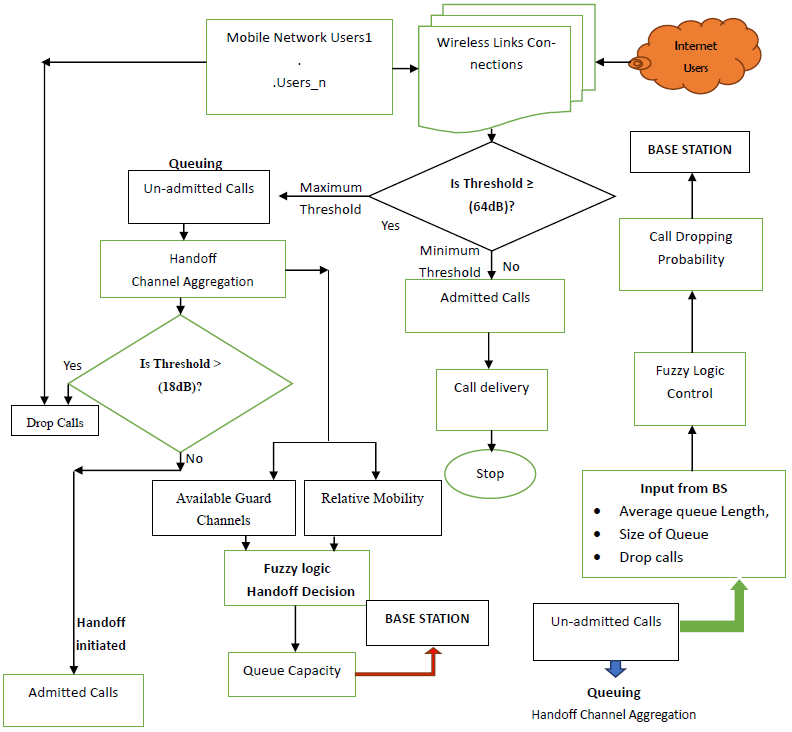 | Figure 1. Architecture of the Proposed system |
As the users send in calls and it gets to the base station, the system performs channel aggregation both for new calls and handoff requests. It assigns channels to subscribers to provide adequate throughput needed to service a specific call. The system determines the range of call block based on the maximum aggregation bandwidth and assigns calls to maximum aggregation bandwidth. The calls that are not assigned a channel are unadmitted calls that are queued in the call registry or the buffer. But calls that are admitted are assigned channels for its transaction processes.The unadmitted calls that are queued up in the call registry, awaits to be signed with specific channels for its service. A Threshold of 18dB was set up in the buffer or the call register, if it is exceeded and the network experiences traffic, the calls awaiting to be assigned cell services are dropped. The available free channel and relative mobility of the network are estimated in the Base Station. These linguistic parameters are used by the proposed fuzzy logic policer to analyze the condition of the network at the queue register and develop intelligent rules to control queue capacity in the base station.
3.1. Algorithm for the Enhanced CAC
Step one: Determine incoming calls in the Base Station.Step two: Analyze new calls and handoff request then perform channel aggregation. Determine call direction of motion, signal strength, mobile’s speed distance from BS, call traffic load and interference. Step three: Assign a channel or channels to subscribers to provide adequate throughput.Step Four: Analyse the wireless links connecting the user and the base station.Step Five: Determine the range of resource block (KHz) assign to a call.Step Six: if calls are admitted, assign one or more channels and go to step one, else unadmitted calls are queued and assigned with specific channels for its service. (i.e. Threshold ≥ (64dB) un-admitted calls; Threshold ≤(64dB) Admitted Calls),Wait for free channel to initialize the call. Determine the direction of mobile’s speed and direction of motion.If traffic is less resulting to enough frequency bands, assign cells to handle calls Step Seven: If Threshold (18dB) is exceeded and If traffic occurs, Drop calls,Determine the level of BS Signal Strength, Relative Mobility and Available Free Channel. Request Fuzzy logic policer to provide fuzzy handoff decision using handoff parameters.INPUTs such as: Relative Mobility and Available free Channel. OUTPUT: Intelligent decision on regulation of the quue capacity in the Base Station (BS).If the Queue Capacity is exceeded, block new incoming calls. Step eight: Estimate queue size of the networks.Step Nine: Estimate the average queue length on the netwoks.Step Ten: Estimate the call drop as a result of network traffics.Step Eleven: Fuzzy congestion controller coordinates and analyzes the performance using Parameters (queue size, average queue length and latency).Step Twelve: Determine and output system Call dropping rate. Step Thirteen: Go-to Step One.
3.2. Linguistic Input/Output Sets
The fuzzy linguistic input and output sets of the proposed rules to improve CAC network QoS are given as follows:Linguistic Input sets for control of Drop probability are determined as: • Size of Queue: {empty, low, moderate, full}, • Average Length of Queue: {low, moderate, high}, and • Call Drop: {little, average, long}.The linguistic Output sets are determined as: • Drop Probability: {zero, low, medium, high}. Linguistic input sets for control of network Queue Capacity are determined as:• Available free Channel: {Very Less, Less, Medium, High, Very High}, • Relative Mobility: {Very Slow, Slow, Moderate, Considerable, Fast, Very Fast}.• Queue Capacity: {Very Low, Low, Moderate, Medium, High, Very High}.The membership function can be formulated for the input and output linguistic variables using trapezoidal or triangular shaped membership functions. For the simplicity, trapezoidal membership function was selected. The membership function should be trained to determine the boundary and the slope of each linguistic term.
3.3. Rule Evaluation
Rules Evaluation determines the rules utilized to obtain the linguistic terms of the output variable from the linguistic terms of the input variables. The linguistic terms of the input are obtained in the previous step. Example of the fuzzy rules is given in Table 1 and 2. However, all these rules will be tested and verified, the final set of rules will be obtained when the experiments are implemented.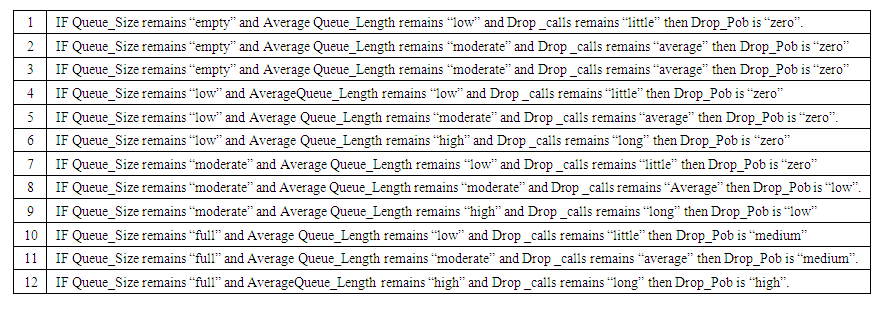 | Table 1. Fuzzy logic rules for Call Drop Probability [12] |
Table 2. Fuzzy logic rules for Queue Capacity Evaluation
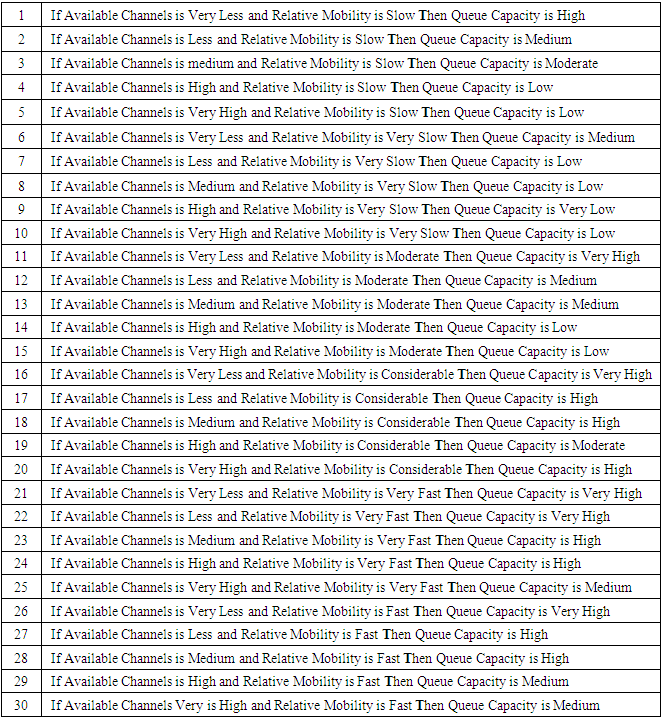 |
| |
|
3.4. Mathematical Models for Handoff Queueing
New call blocking probability (Bnew) and Blocking probability Bhandoff of a handoff demand are given as follow:i. New call blocking probability (Bnew) | (1) |
Where C_CH represents the limited amount of code channels accessible in the channel pool. In most cases each channel reserves channels wholly for management of queue issues.MN represents Queue capacity in the Base Station.P(q) represents the steady state probabilityii. Blocking probability Bhandoff as given in equation 2 | (2) |
3.4.1. Mathematical Model for Fuzzification of Input Terms
The probability values of the input linguistic terms obtained in the fuzzification step and produces a probability for the linguistic term of the output variable are given as follows: | (3) |
where μQsize (x) is the probability value for input variable “size of queue”μQlength (x) represents the probability value for input variable “Average queue length”μDropcalls is the probability value for fuzzified input value of Drop calls. This step takes the probability values of the input linguistic terms obtained in the fuzzification step and produces a probability for the linguistic term of the output variable. As expected, the same linguistic term for the output variable may be obtained because the rules with the same output term are applied. These identical terms are aggregated in a single output with an underlying term and a probability value (that is the maximum among the calculated probabilities for that term).
3.4.2. Mathematical Model for Defuzzification Output Terms
The defuzzification process defuzzied the intelligence solution of the fuzzy Inferences engine of the linguistic values to logics. The defuzzification process produced crisp rate control value which is sent to the source. The Center of Gravity (CoG) method is employed for defuzzification. This method works by computing the Centre of the composite area that represents the output of fuzzy set. Given that several output linguistic terms are expected to be extracted as several rules, equation 4 is used to calculate the final output crisp result. | (4) |
Where the numerator is the probability of each linguistic term for the output variable multiplied by the values of the term in the fuzzy set. Meanwhile, the denominator is the number of values for that term in the fuzzy set. The basic parameters for simulation is shown in Table 3.Table 3. Parameters for simulation
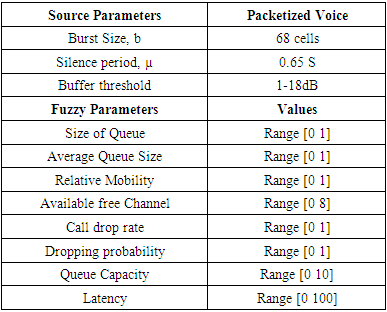 |
| |
|
4. Results
MATLAB Integrated Development Environment (IDE) was used for the simulation of the ECAC model. The MATLAB IDE facilitates the development of Fuzzy logic integrated components such as Inputs of the parameters that will be fuzzified and sent to the fuzzy inference engine and then the defuzzification of the output control of the ECAC. The diagram for the fuzzy logic controller is shown in Figure 2. Figure 3 represents the rule base inference engine for the proposed ECAC while the membership functions for fuzzification of the input parameters for the queue size, queue length, drop call, available free channel and relative mobility are presented in figures 4-8 respectively. Figures 9 and 10 showed the memberships functions for output parameters on drop probability and queue capacity. 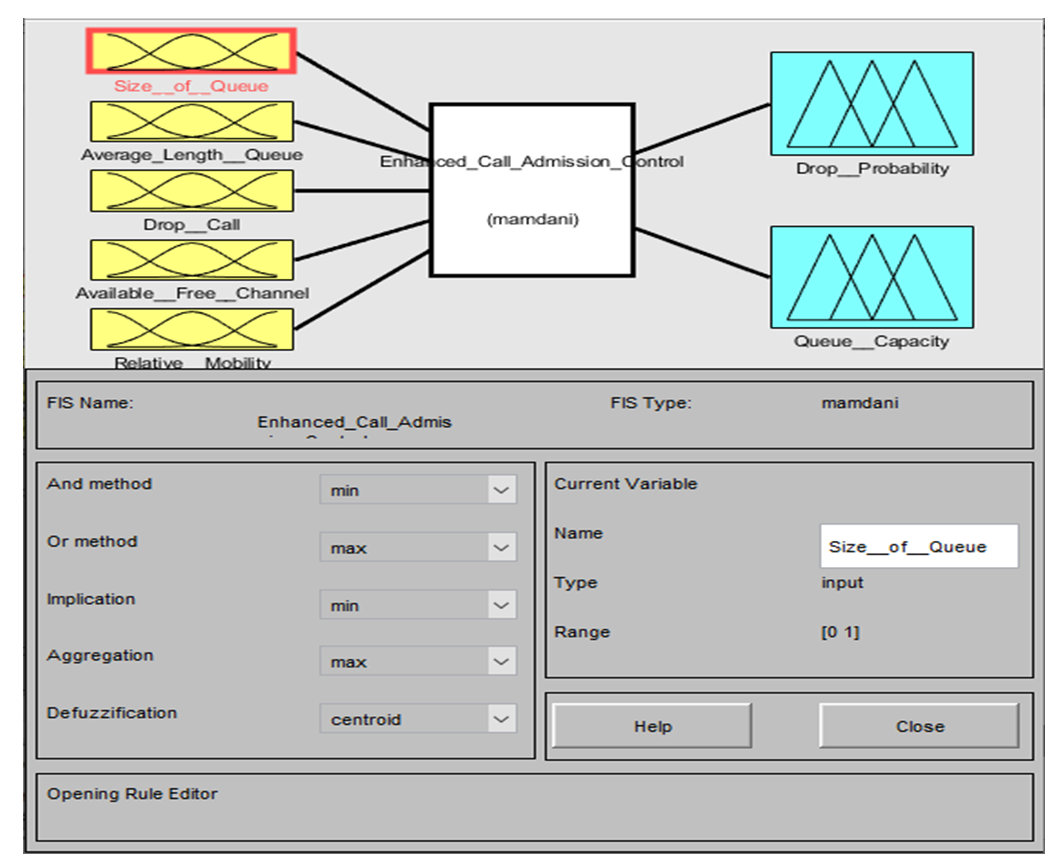 | Figure 2. Fuzzy Logic controller design for the proposed ECAC |
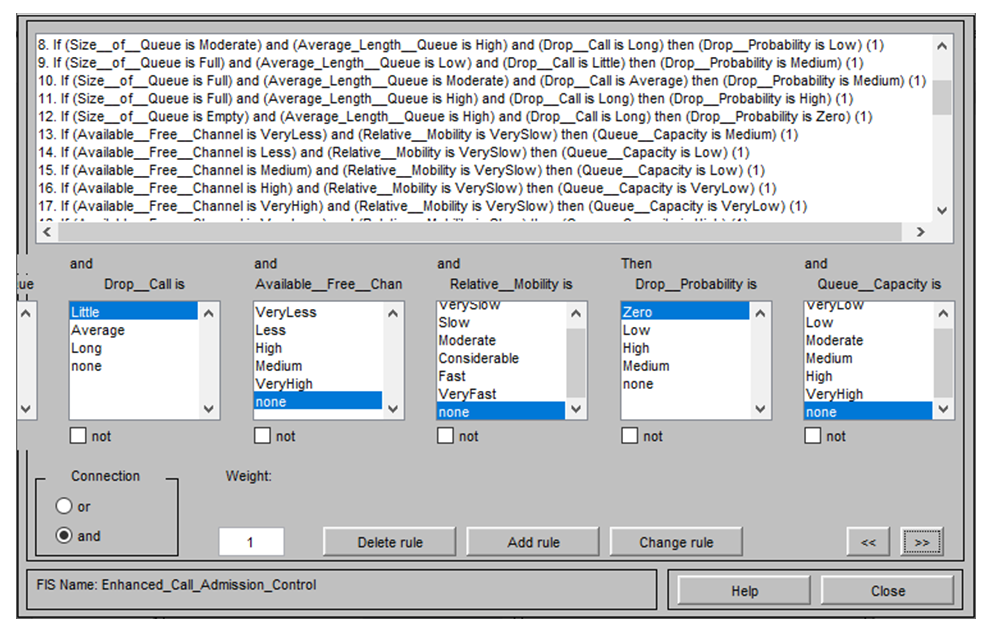 | Figure 3. Rule base inference Engine for the Proposed ECAC |
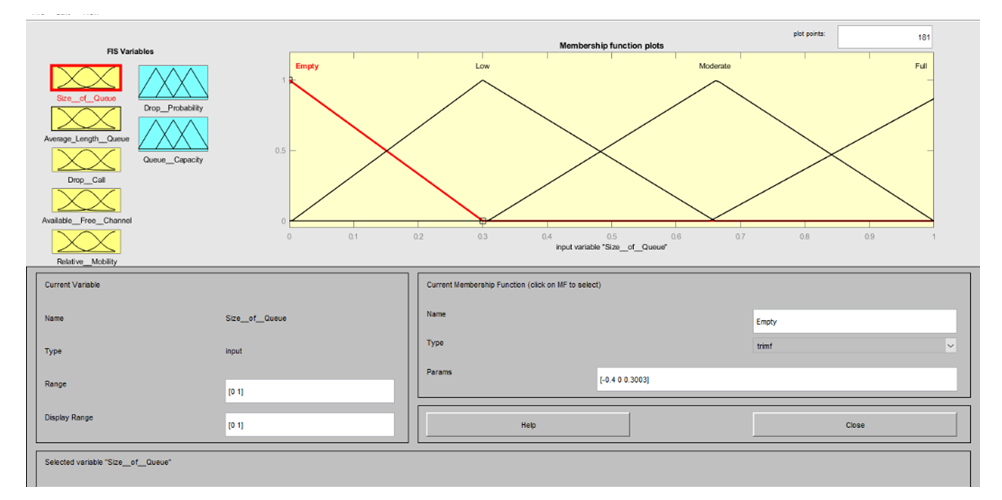 | Figure 4. Membership function for input parameter Size of Queue |
 | Figure 5. Membership function for input parameter Average Length of Queue |
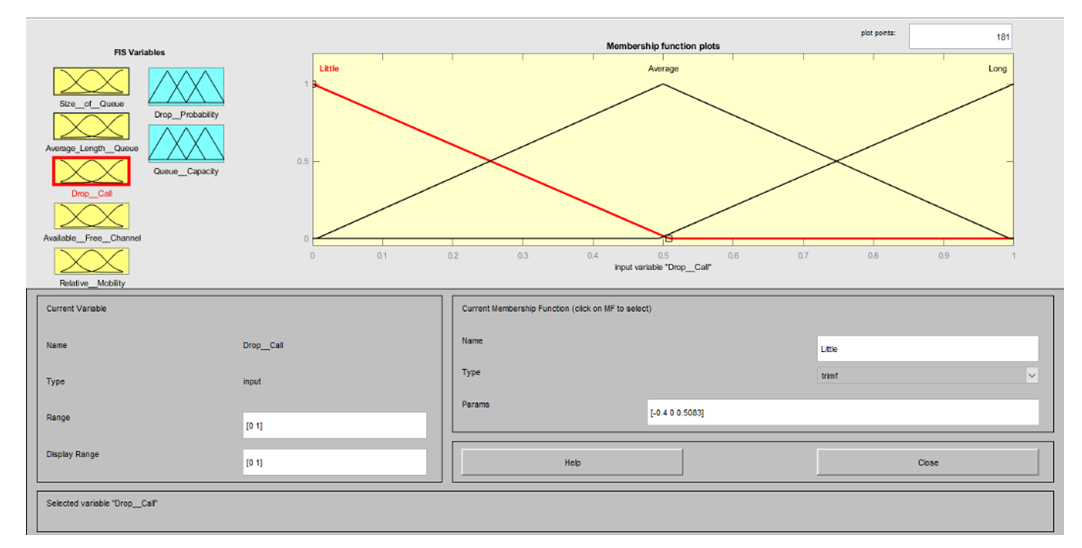 | Figure 6. Membership function for input parameter for Drop call |
 | Figure 7. Membership function for input parameter Available Free Channel |
 | Figure 8. Membership function for input parameter Relative Mobility |
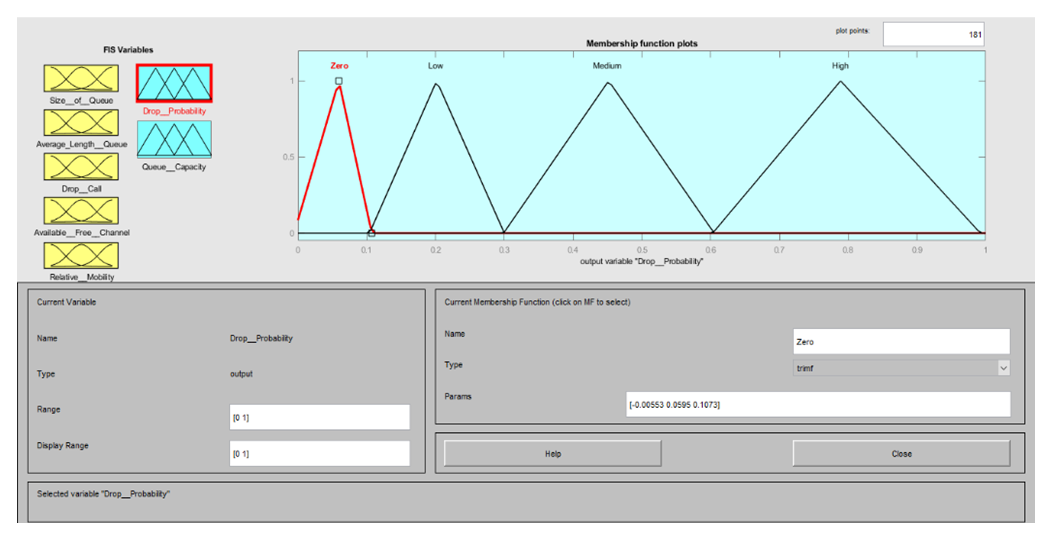 | Figure 9. Membership function for output parameter Drop call Probability |
 | Figure 10. Membership function for output parameter Queue Capacity |
Figure 11 illustrates the simulation performance of various network variations relative to the call drop probabilities. The network variations on call admission control mechanisms were considered from one (1) to seven (7). Relevant parameters such as call drop, average length of queue and queue capacity were evaluated to analyze the call drop probabilities. The size of the queue determines the call drop probability. The outcome of the graphical illustrations clearly identifies varying conditions needed for admitting new calls. Figure 12 compares the proposed system with the non-fuzzy and fuzzy (conventional) systems. The proposed system outperforms the non-fuzzy and fuzzy system, with reduced call drop probability, given rise to improved handoff performance. Also, the system performance enables provision of good decision concept in queueing, handover, accepting or rejecting of calls. Figure 13, illustrates intelligent decision outcome of the regulation for the queue capacity on different network variations. The system uses available free channel and relative mobility as inputs to logically predict the queue capacity at any network variation in the system. It is clearly observed from the outcome of the parametric values simulated using Fuzzy Efficient Call Admission Control algorithm, provided a low call drop probability, given rise to a better handoff performance. The study shows a good control mechanism for the call on the channels to ensure call drop rate, congestion at the buffer and call block rate are reduced to an acceptable level to achieve desired quality of service delivery. 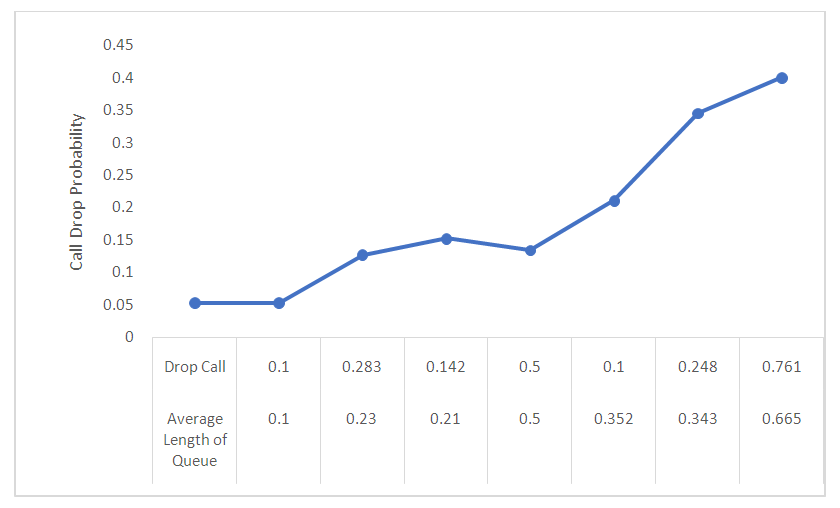 | Figure 11. Outcome of the proposed ECAC algorithm |
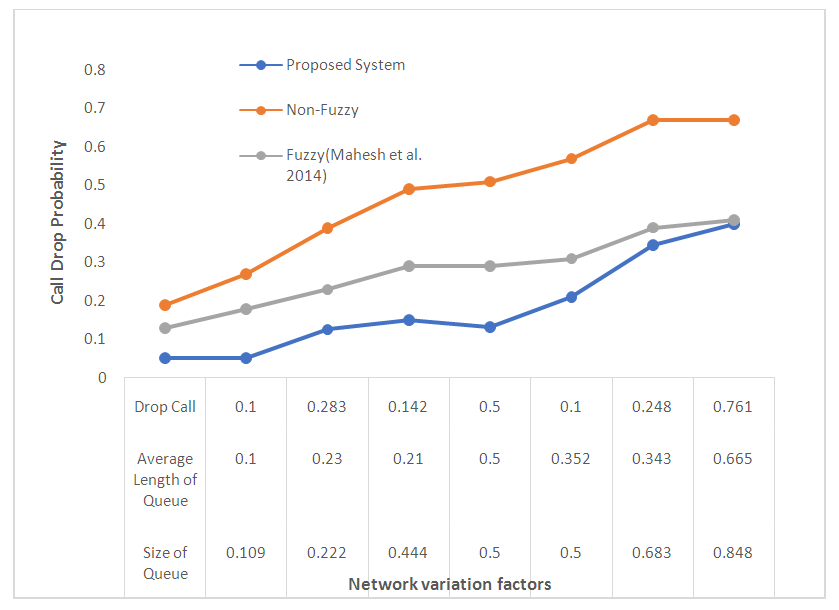 | Figure 12. Comparison of the proposed and existing CAC system |
 | Figure 13. ECAC Intelligent decision on regulation of the queue capacity in the Base Station (BS) |
The proposed technique implemented fuzzy inference mechanism intelligence to predict the queue capacity regulation in the Base Station using linguistic parameter inputs such as “Available cell channels” and “Relative mobility fuzzified in the system. The procedure ensured that the incoming calls did not exceed the queue capacity in the base station. It was constructed to automatically drop incoming call when there is traffic in the queue buffer and handoff calls in use for calls admission. This was achieved by placing a threshold of 18dB such that if the capacity of the calls in the buffer exceeds the threshold some of the calls will be dropped and the others will be initialized on the free available channels. The mean value of the network variations for the proposed model, fuzzy and non-fuzzy-models was evaluated to ascertain the performance improvement of the proposed system over the conventional system. The results obtained gave a 20.32% improvement over the fuzzy system and 43.60% over the non-fuzzy system. This approach of managing the calls in the buffer of the queue scheme helped to improve the quality of service of the network by preventing interference and decongesting the buffer.
5. Conclusions
The goal of the research study is to develop an enhanced scheme for Mobility Management in LTE wireless networks. Fuzzy logic intelligent mechanism was applied to analyze and develop an intelligent technique to control the uncertainties and variation that results due to poor QoS delivery. The mechanism was developed to manage handoff calls in the queue with regards to limited queue scheme. The analysis of the call route aggregation performance was carried out to identify the step-by-step approach on the call route aggregation protocols and the pattern it was integrated for QoS enhancement. This approach guided the directions of the research work firstly, on the design of the thresholds in the Base Station and the queue scheme. Measures were placed to regulate new incoming calls with the threshold of 64dB assigned in the Base Station and 18dB threshold in the limited queue scheme. Secondly, Queue based model mechanism was formulated to handle new and handoff calls using queueing scheme. And thirdly, the handoff based fuzzy logic analysis for Call Admission Control was configurated based on the call route aggregation analysis. The observations from the literatures guided the development of the scheme to address the gaps.
References
| [1] | Georgios I. Tsiropoulos, Dimitrios G. Strtogianms, Eirini Eleni Tsiropoulous, Call Admission Control in mobile and wireless networks, Mobile & Wireless Communication network layer and Circuit level design, 2010. |
| [2] | Yuguang Fang and Yi Zhang, Call Admission Control Schemes and performance analysis in wireless mobile networks, IEEE Transactions on Vehicular Technology, 51(2), 371-382, 2002. |
| [3] | Vyshnavi V.S.S, Sunitha T., A Call Admission Control Algorithm to enhance the network management in Heterogenous wireless networks, 2016. |
| [4] | Daniel E. Asoquo, Edem E. William, Enoch. O. Nwachukwu, A Survey of Call Admission Control Schemes in Wireless Cellular Network, International journal of scientific and engineering research, vol 5 issue 2, 2014. |
| [5] | Satyabrata Chakrabarti and Amitabh Mishra, Quality of Service challenges for wireless mobile ad hoc networks Wireless Communication and Mobile computing, Volume 4, issue 2, pp129-153, 2004. |
| [6] | Mahesh G, Yeshwanth S., Dr. Gowrishankar, Fuzzy Logic based Call Admission Control for Next Generation Wireless Networks. International Journal of Advanced Research in Computer and Communication Engineering Vol. 3, Issue 8, August 2014. |
| [7] | Raghavendra G., Balachandra M. and Predeep P., Characteristic Analysis of VoIP Traffic for Wireless Networks in Comparison with CBR using QualNet Network Simulator. International Journal of Computer Application, Vol, 50, Issue 11, Pp 25-31, 2012. |
| [8] | Vijay Franklin J., Paramasivan K, Hybrid Adaptive Call Admission Control mechanism for ensuring Qos in 3GPP: LTE Network, 2012. |
| [9] | Hamid Beigy and Mohammad Reza Meybodi, A New Continuous Action-Set Learning Automaton for Function Optimization” Journal of the Franklin Institute 343(1): 27-47, DOI: 10.1016, j.jfranklin.2005.07.004, 2006. |
| [10] | Vijay Franklin J, Paramasivian K., Persistent scheduler-based Call Admission Control for long term evolution (3GPP) network, 2013. |
| [11] | Deepak Kumar Mahato, Amrita Khera, Optimization of Adaptive Call Admission Control Schemes for LTE Networks with Bandwidth Reservation. International Research Journal of Engineering and Technology, vol 8, issue 4, pp 3094-3097, 2021. |
| [12] | Ravi S, Sanjiv T., A comparative analysis of queuing and fuzzy logic-based admission control scheme in CDMA Cellular networks, 2012. |





















 Abstract
Abstract Reference
Reference Full-Text PDF
Full-Text PDF Full-text HTML
Full-text HTML
